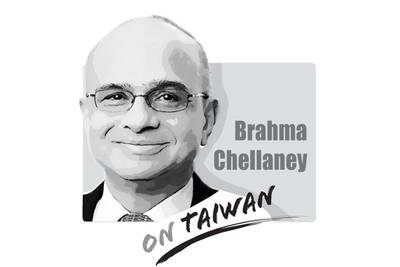Some opposition lawmakers have proposed tasking the central bank with creating a sovereign wealth fund financed by the nation’s foreign exchange reserves to boost investment returns. They have clearly conflated the monetary regulator’s job with that of a fund manager.
Taiwan People’s Party Legislator Cynthia Wu (吳欣盈) proposed allocating 10 percent of the nation’s foreign reserves — US$560.2 billion as of last month — to a sovereign wealth fund, following in the footsteps of Norway, Singapore, China and South Korea.
Taiwan has the world’s fourth-largest foreign exchange reserves, which last month rose for a record sixth consecutive month.
Wu said that in light of such massive reserves, the 2.6 percent annual return on the central bank’s management of foreign exchange reserves was too low, compared with the average 7 percent that Singapore’s sovereign wealth fund, GIC Pte, has yielded since its inception in 1981.
A similar sovereign wealth fund run by the central bank could seek the highest financial returns by diversifying its investment targets, Wu said, adding that investing in foreign companies with strategic technologies could enhance Taiwan’s global clout.
She said the creation of such a fund is imperative, as about 80 percent of G20 countries have set up sovereign wealth funds, adding that 64 other lawmakers have endorsed her proposal.
However, Wu’s plan does not go beyond wishful thinking, as there is no guarantee that an investment will be profitable. Furthermore, higher returns require higher risks, while investing in companies with strategic technologies does not mean owning the technologies, nor playing a deciding role in steering the companies’ operations.
Norway’s sovereign wealth fund, the Norwegian Government Pension Fund Global, the biggest of its kind, lost US$167 billion last year, with an annual return rate of minus-13.9 percent.
The central bank’s main tasks are to keep inflation within its target range, and maintain stability in the financial markets and the local currency, as Taiwan is prone to volatility in external markets. Turning a profit has never been the bank’s first priority.
More importantly, Taiwan must protect itself from potential financial meltdowns, as it is not a member of the IMF and external aid might not always be on hand.
Large foreign exchange reserves are a protection tool and can provide emergency capital for local lenders during tough times. Taiwan’s deep foreign exchange reserves helped it weather global financial crises in 1997 and 2008.
A large portion of Taiwan’s foreign exchange reserves is constituted by local stocks and bonds held by foreign investors, with a market value of US$538.9 billion. Any significant outflows could cause a drastic reduction in foreign exchange reserves.
A sovereign wealth fund invests in real and financial assets. Taiwan already has four such wealth funds, including the Labor Pension Fund. Before the government can consider setting up a new sovereign wealth fund, there are several questions that need to be answered: What is the purpose of setting up a new fund? How will the fund be financed? Is it appropriate to finance the fund from the nation’s foreign exchange reserves? Does the fund need to be operated by the central bank?
The lawmakers who proposed setting up such a fund should have thought twice about their plan.
The government and local industries breathed a sigh of relief after Shin Kong Life Insurance Co last week said it would relinquish surface rights for two plots in Taipei’s Beitou District (北投) to Nvidia Corp. The US chip-design giant’s plan to expand its local presence will be crucial for Taiwan to safeguard its core role in the global artificial intelligence (AI) ecosystem and to advance the nation’s AI development. The land in dispute is owned by the Taipei City Government, which in 2021 sold the rights to develop and use the two plots of land, codenamed T17 and T18, to the
US President Donald Trump has announced his eagerness to meet North Korean leader Kim Jong-un while in South Korea for the APEC summit. That implies a possible revival of US-North Korea talks, frozen since 2019. While some would dismiss such a move as appeasement, renewed US engagement with North Korea could benefit Taiwan’s security interests. The long-standing stalemate between Washington and Pyongyang has allowed Beijing to entrench its dominance in the region, creating a myth that only China can “manage” Kim’s rogue nation. That dynamic has allowed Beijing to present itself as an indispensable power broker: extracting concessions from Washington, Seoul
Taiwan’s labor force participation rate among people aged 65 or older was only 9.9 percent for 2023 — far lower than in other advanced countries, Ministry of Labor data showed. The rate is 38.3 percent in South Korea, 25.7 percent in Japan and 31.5 percent in Singapore. On the surface, it might look good that more older adults in Taiwan can retire, but in reality, it reflects policies that make it difficult for elderly people to participate in the labor market. Most workplaces lack age-friendly environments, and few offer retraining programs or flexible job arrangements for employees older than 55. As

Donald Trump’s return to the White House has offered Taiwan a paradoxical mix of reassurance and risk. Trump’s visceral hostility toward China could reinforce deterrence in the Taiwan Strait. Yet his disdain for alliances and penchant for transactional bargaining threaten to erode what Taiwan needs most: a reliable US commitment. Taiwan’s security depends less on US power than on US reliability, but Trump is undermining the latter. Deterrence without credibility is a hollow shield. Trump’s China policy in his second term has oscillated wildly between confrontation and conciliation. One day, he threatens Beijing with “massive” tariffs and calls China America’s “greatest geopolitical